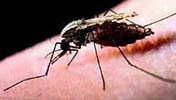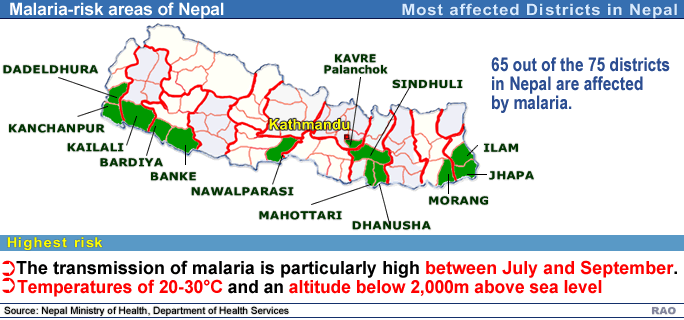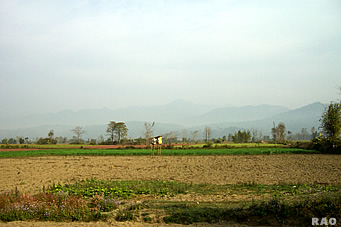 |
|
 |
| Malaria in Nepal |
| The incidence of malaria increases between July and September 2008 in Nepal |
 |
|
Around the world 54 percent of the population lives in the areas where malaria exists. It is the most important public health problem in the tropical and sub tropical regions in summer seasons.
It
is estimated that around 100 million clinical cases occur each year and
the actual number of persons infected is about 250 million. Many undiagnosed
and sub-clinical cases may be the persistent sources of transmission to
others.
Around the world 54 percent of the population lives in the areas where malaria exists. It is the most important public health problem in the tropical and sub tropical regions in summer seasons. In context of Nepal, it is very much prevalent in the Terai region. In each person with high-grade fever, malaria should be suspected if he / she is from Terai. The disease exists in areas less than 2000 m from the sea level.Sarita Chettri rubs mosquito repellant on her children before securing the mosquito net. "We have to be very careful for the next three months," the 30-year-old mother told IRIN in Pachkhal village, Kavre District, nearly 50km southeast of the capital, Kathmandu, where malaria is rife.
 |
Kavre is one of Nepal's most affected districts and transmission is particularly high between July and September, says Nepal's Ministry of Health, Department of Health Services.
According to the department's epidemiology and disease control division, 65 out of the 75 districts are deemed malaria-endemic - affecting nearly 79 percent of the country's 28 million inhabitants.
Worst at risk are 13 districts, including Kavre, where temperatures of 20-30 Centigrade and an altitude below 2,000m make them ideal mosquito breeding grounds.
The other districts include Sindhuli, Ilam, Jhapa, Morang, Mohatari and Dhanusa in the eastern region; Banke and Bardiya in the mid-west, and Kanchanpur, Kailali and Dadeldhura in the far west, as well as Nawalparasi in central region.
Geographically divided into mountains ("parbat"), hills ("pahad") and lowland plains ("Terai"), the Himalayan nation is administratively divided into five development regions - far west, mid-west, west, central and east.
Most
of the districts affected are in the eastern region of the Terai, where
the climate is particularly hot and humid. Compared with the mountain and
hill areas, the Terai is the most populated, according to Nepalese government
statistics.
| Environmental challenges |
Although the mortality rates due to malaria are low (five to seven reported death annually), the incidence rate is 5,000-7,000 every year, according to the epidemiology division, which explained that malaria eradication is quite difficult due to Nepal's tropical climate.
 |
|
The rapid deforestation had led to floods and landslides, as well as water logging, which hosts breeding places for mosquitoes. In addition, migrant workers often left their villages for Indian and Nepalese cities rampant with malaria problems, only to return infected.
Moreover,
the lack of behavioural change among vulnerable communities, lack of mosquito
nets, no indoor residual spraying and delayed treatment, had contributed
to malaria outbreaks, he added.
| Malaria remains endemic in many parts of Nepal - Migration issues |
The steady industrialisation of the Terai - the country's most fertile and lowland region bordering India - has also led to a lot of water logging where malaria vector intensity grows, according to epidemiology division officials.
"Nepal also has an active migrant population moving frequently to malaria-risk areas of India like Assam and other northeastern states for livelihood and they return home infected and easily transmit malaria," said Thakur.
According to the UN World Health Organization (WHO), malaria is a major health problem in Assam and other eastern states.
In eastern Terai, according to the District Public Health Office (DPHO), the threat of malaria is large and more than 300 cases have been detected since March in a single district of Morang, 500km southeast of Kathmandu.
"So far we have already distributed 400,000 long-lasting insecticidal nets and been actively involved in improving services for immediate diagnosis and treatment," explained Thakur.
| Improved mortality |
Nepal has come a long way in reducing mortality and morbidity rates since it started its malaria control programme in 1954, according to the epidemiology division, which explained that the annual number of reported malaria cases has been reduced from 200,000 then to only 5,000-7,000 now.
The country aims to cut malaria cases in half by 2015 in line with its Millennium Development Goal.
Thakur said the government had made plans to distribute about 2.2 million mosquito nets to the poor and build better services in all public health centres to provide free diagnosis and immediate treatment to the poorest communities.
Copyright UN Office for the Coordination of Humanitarian Affairs 2008
[ This report does not necessarily reflect the views of the United Nations]
Integrated Regional Information Networks (IRIN), part of the UN Office for the Coordination of Humanitarian Affairs (OCHA).
| Links |
| Externe Links |
 |
| Terai |
 |
|
|